This was a stressful bake. Mainly because lots of things did not go as planned and I had to think on my feet. I prefer mindless baking... thinking baking is stressful. The loaf came out nice though, a bit gummy, but nice.
I was thinking how I would blog about this bake, if I walked through the bake in chronological order, the blog post would get even more tedious than my normal blog posts. So, I think I will write a short summary about what went wrong and then write down the bake as it actually occurred without including the missteps along the way.
Basically, I started with a recipe that had 325g of non-flour non-water ingredients, or 205g more than my previous bake. Considering my recipe only had 450g of flour, 325g of add-ins was a bit insane. And, I realized my oversight after I mixed all 325g of ingredients together (50g rolled oats, 50g potato, 25g chia seeds, 25g cracked wheat, 30g honey, 15g salt, 30g olive oil, 25g hemp hearts, 25g flax seeds, 50g quinoa) along with the water. Visually, it was obvious that this was too much!
So, before adding the flour, I made some adjustments, I gave half of the mixture to the chickens, added back some water, honey, salt, and oil to get back to the desired ratio, and then proceeded to mix in the flour.
Recap:
The wife has tasked me to come up with a sandwich bread recipe our family can bake at least once a weak to completely replace our regularly purchased box store sandwich bread.
Requirements
- Soft and light
- 100% whole wheat
- Recipe must be easily repeatable and easy to execute.
- Recipe must be designed for a covered pullman loaf pan.
(https://shop.kingarthurbaking.com/items/pain-de-mie-pan-pullman-loaf-pan-13) - My 12 year old daughter must be able to bake the bread from start to finish
- Sourdough leavening only.
- From start to finish, the bread must be completable in 1 day.
- Process must exist to enable the baker to know with reasonable certainty that the loaf is perfectly proofed.
- Dough needs to contain a few softened chewy seeds, grain berries, etc. for texture and flavor.
- Don't use bran flakes as a bread topping.
- 1.5 out of 10 on the TexasBakerDad sourness scale, whatever the heck that means :-)
Summary of the Bake
The Good:
- I was able to save the bake.
- The flavor was mild and nice.
- The crust was soft.
- I think the density was just about perfect.
- I liked the seed density from a visual perspective.
The Bad:
- The dough was too sticky after mixing, I was able to shape it, but it wasn't fun.
- The crumb was too gummy. I think this is probably due to too many starchy elements in the addins. I will try removing half of them (probably just remove all of the chia seeds).
- The potatoes took too long to soften and I lost a lot of water while boiling them. Should be able to fix by using a grater instead of chopping into small cubes. And, I should only soften the potatoes and cracked wheat at first, then add the rest of the addins once they are softened.
- The oats didn't stick too well when I rolled the dough in them.
- The dough was hard to score... either my razor blade was dull after only 2 uses, OR, something about this dough makes it hard to score.
What to do Next:
- Remove chia seeds, but add back in black sesame seeds. Hopefully this will help bring down the gummyness.
- Boil the potatoes and cracked wheat seperately
- Reduce moisture to hopefully reduce stickiness after mixing. This should also help bring down the gummyness.
- Try brushing and sprinkling oats on top.
- Measure weight before and after boiling potatoes so I can know exactly how much water is lost while softening the potato.
- Get my hands on a sweet potato and try it instead of a russet.
Ingredients:
- 60g sourdough starter (50:50 hard white wheat)
- 25g rolled oats
- 25g russet potato
- 25g quinoa
- 12g chia seeds
- 12g hemp hearts
- 12g cracked wheat
- 30g honey
- 10g non-iodized salt
- 30g extra virgin olive oil
- 550g well water
- 360g hard white wheat
- 45g dark rye
- 45g spelt
- More rolled oats used as topping.
Process:
- 9:40a: Peel russet potato and chop 25g of it into tiny pieces
- 9:43a: Put potato, rolled oats, quinoa, honey, sesame seeds, cracked wheat, and 550g of water into a sauce pan and bring to a boil. Boil until potatoes have softened. About 30 minutes.
- 10:13a: Weight mixture, add water to get it back to 550g since water was lost during the boil.
- 10:14a: Add oil and mix. Also wait until water comes down below 110dF, it was 90dF after all of my shenanigans.
- 10:15a: Mix in all of the flours into a shaggy mess. Then let sit for 10 minutes.
- 10:25a: Smear 60g starter over the top of the dough mess. Use drum on Ankarsum and knead until dough stops showing improvement (record time elapsed, about 8 minutes).
- 10:37a: Dump dough onto bench, siphon off 20g for aliquot, then preshape into 4 equally weighted balls, then wait 15 min.
- 10:45a: Prepare pullman pan
- 11:05a: Shape dough and load into pan, roll tops into oats on bench, seem sides facing inwards?
- Let dough proof in pullman until aliquot shows 1.7x rise over original volume.
- 5:00p: Preheat Oven to 375dF
- 5:46p: Score, put lid on pullman and bake in oven covered for 1 hour 15 min.
- 7:01p: Pull from oven, transfer to rack to cool. Let cool for at least 2.5 hours.
- 9:30p: Slice and enjoy.
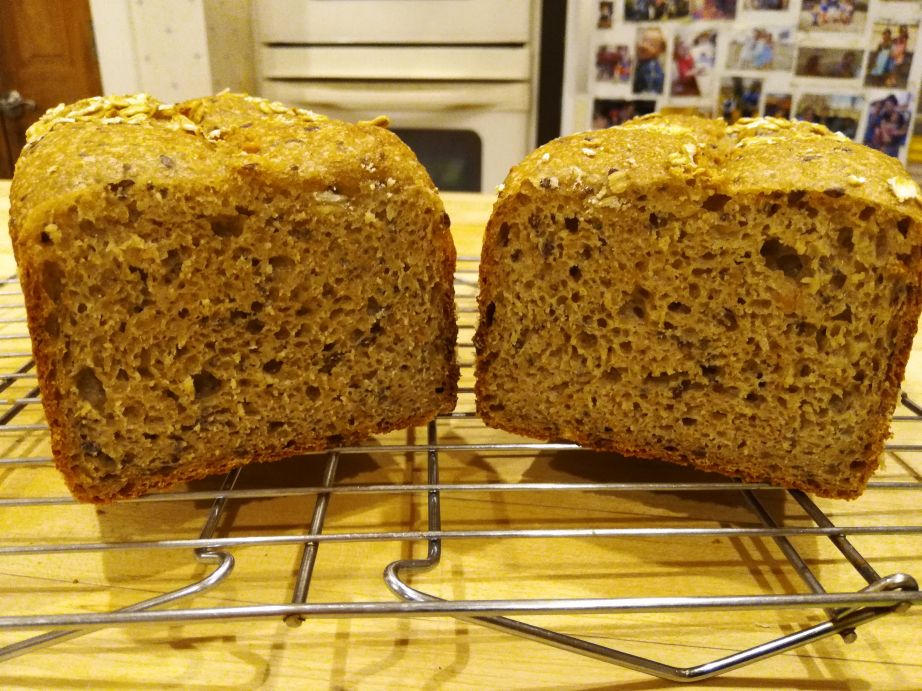
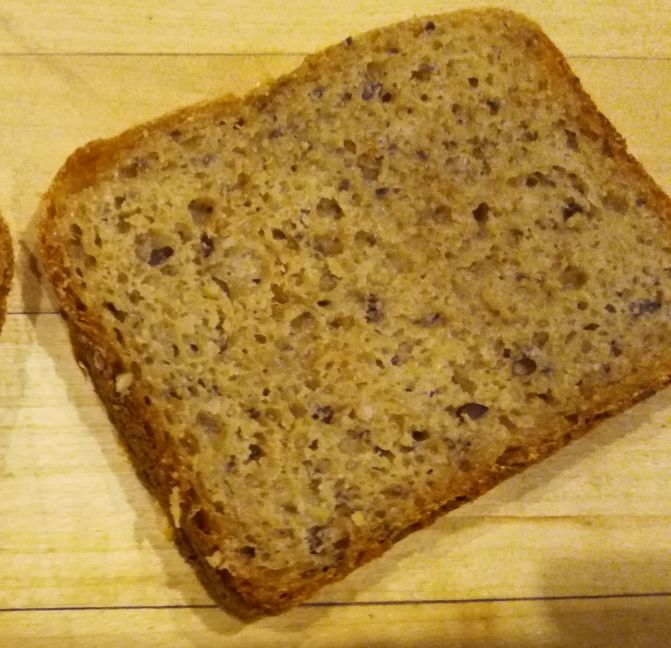


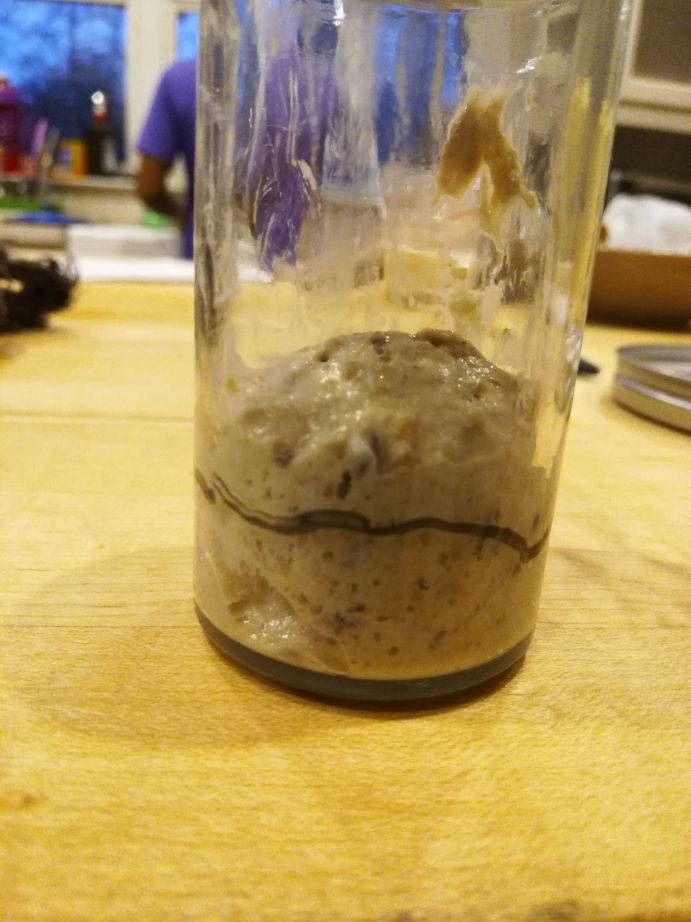
aliquot right before loading into oven.

right before loading into oven

Dough right after shaping and loading into pullman

preshaped dough
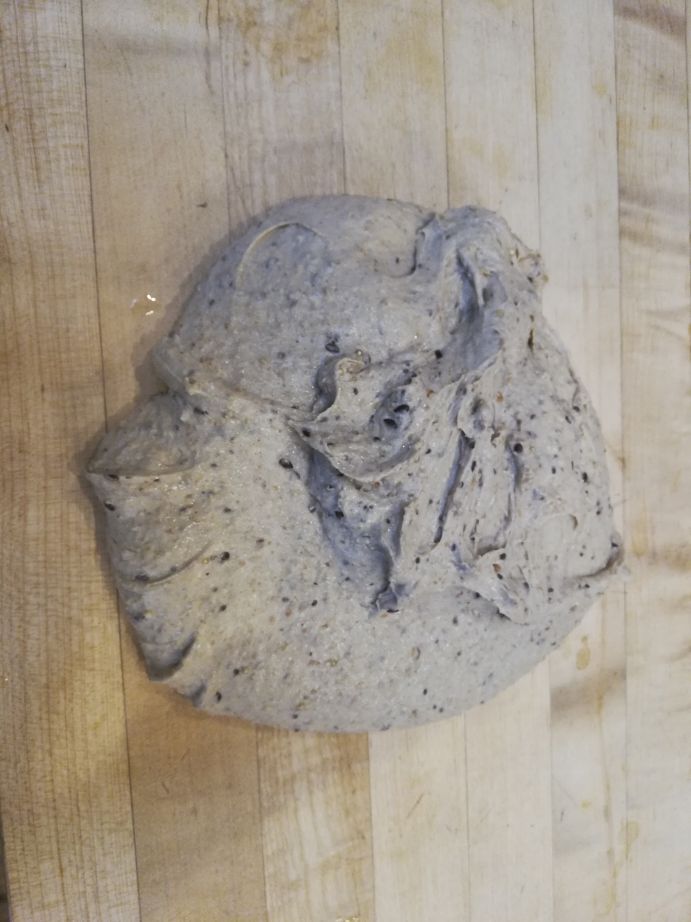
The dough right before preshaping it
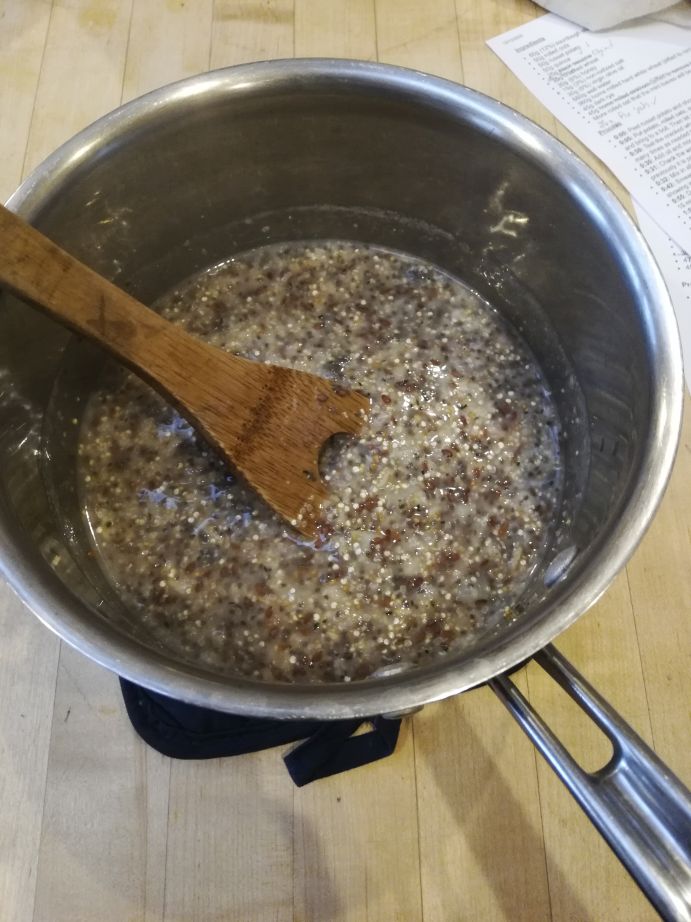
The addins mixture after a long boil, before I gave half to the chickens.